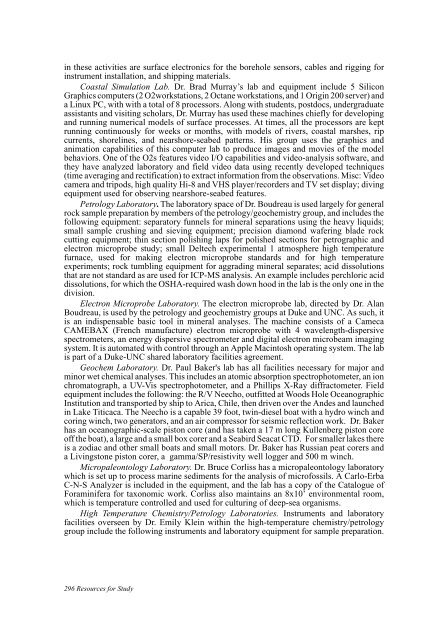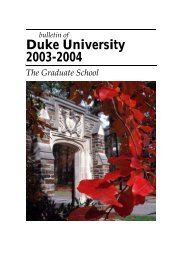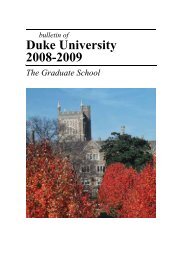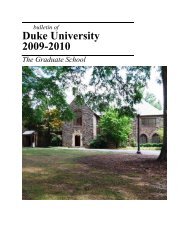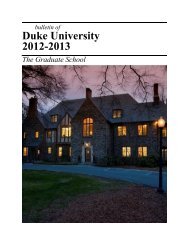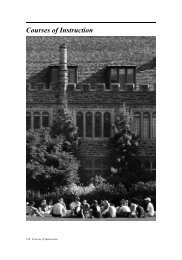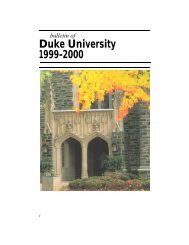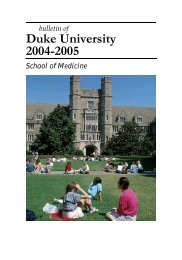2005-06 - Office of the Registrar - Duke University
2005-06 - Office of the Registrar - Duke University
2005-06 - Office of the Registrar - Duke University
Create successful ePaper yourself
Turn your PDF publications into a flip-book with our unique Google optimized e-Paper software.
in <strong>the</strong>se activities are surface electronics for <strong>the</strong> borehole sensors, cables and rigging for<br />
instrument installation, and shipping materials.<br />
Coastal Simulation Lab. Dr. Brad Murray’s lab and equipment include 5 Silicon<br />
Graphics computers (2 O2workstations, 2 Octane workstations, and 1 Origin 200 server) and<br />
a Linux PC, with with a total <strong>of</strong> 8 processors. Along with students, postdocs, undergraduate<br />
assistants and visiting scholars, Dr. Murray has used <strong>the</strong>se machines chiefly for developing<br />
and running numerical models <strong>of</strong> surface processes. At times, all <strong>the</strong> processors are kept<br />
running continuously for weeks or months, with models <strong>of</strong> rivers, coastal marshes, rip<br />
currents, shorelines, and nearshore-seabed patterns. His group uses <strong>the</strong> graphics and<br />
animation capabilities <strong>of</strong> this computer lab to produce images and movies <strong>of</strong> <strong>the</strong> model<br />
behaviors. One <strong>of</strong> <strong>the</strong> O2s features video I/O capabilities and video-analysis s<strong>of</strong>tware, and<br />
<strong>the</strong>y have analyzed laboratory and field video data using recently developed techniques<br />
(time averaging and rectification) to extract information from <strong>the</strong> observations. Misc: Video<br />
camera and tripods, high quality Hi-8 and VHS player/recorders and TV set display; diving<br />
equipment used for observing nearshore-seabed features.<br />
Petrology Laboratory. The laboratory space <strong>of</strong> Dr. Boudreau is used largely for general<br />
rock sample preparation by members <strong>of</strong> <strong>the</strong> petrology/geochemistry group, and includes <strong>the</strong><br />
following equipment: separatory funnels for mineral separations using <strong>the</strong> heavy liquids;<br />
small sample crushing and sieving equipment; precision diamond wafering blade rock<br />
cutting equipment; thin section polishing laps for polished sections for petrographic and<br />
electron microprobe study; small Deltech experimental 1 atmosphere high temperature<br />
furnace, used for making electron microprobe standards and for high temperature<br />
experiments; rock tumbling equipment for aggrading mineral separates; acid dissolutions<br />
that are not standard as are used for ICP-MS analysis. An example includes perchloric acid<br />
dissolutions, for which <strong>the</strong> OSHA-required wash down hood in <strong>the</strong> lab is <strong>the</strong> only one in <strong>the</strong><br />
division.<br />
Electron Microprobe Laboratory. The electron microprobe lab, directed by Dr. Alan<br />
Boudreau, is used by <strong>the</strong> petrology and geochemistry groups at <strong>Duke</strong> and UNC. As such, it<br />
is an indispensable basic tool in mineral analyses. The machine consists <strong>of</strong> a Cameca<br />
CAMEBAX (French manufacture) electron microprobe with 4 wavelength-dispersive<br />
spectrometers, an energy dispersive spectrometer and digital electron microbeam imaging<br />
system. It is automated with control through an Apple Macintosh operating system. The lab<br />
is part <strong>of</strong> a <strong>Duke</strong>-UNC shared laboratory facilities agreement.<br />
Geochem Laboratory. Dr. Paul Baker's lab has all facilities necessary for major and<br />
minor wet chemical analyses. This includes an atomic absorption spectrophotometer, an ion<br />
chromatograph, a UV-Vis spectrophotometer, and a Phillips X-Ray diffractometer. Field<br />
equipment includes <strong>the</strong> following: <strong>the</strong> R/V Neecho, outfitted at Woods Hole Oceanographic<br />
Institution and transported by ship to Arica, Chile, <strong>the</strong>n driven over <strong>the</strong> Andes and launched<br />
in Lake Titicaca. The Neecho is a capable 39 foot, twin-diesel boat with a hydro winch and<br />
coring winch, two generators, and an air compressor for seismic reflection work. Dr. Baker<br />
has an oceanographic-scale piston core (and has taken a 17 m long Kullenberg piston core<br />
<strong>of</strong>f <strong>the</strong> boat), a large and a small box corer and a Seabird Seacat CTD. For smaller lakes <strong>the</strong>re<br />
is a zodiac and o<strong>the</strong>r small boats and small motors. Dr. Baker has Russian peat corers and<br />
a Livingstone piston corer, a gamma/SP/resistivity well logger and 500 m winch.<br />
Micropaleontology Laboratory. Dr. Bruce Corliss has a micropaleontology laboratory<br />
which is set up to process marine sediments for <strong>the</strong> analysis <strong>of</strong> micr<strong>of</strong>ossils. A Carlo-Erba<br />
C-N-S Analyzer is included in <strong>the</strong> equipment, and <strong>the</strong> lab has a copy <strong>of</strong> <strong>the</strong> Catalogue <strong>of</strong><br />
Foraminifera for taxonomic work. Corliss also maintains an 8x10’ environmental room,<br />
which is temperature controlled and used for culturing <strong>of</strong> deep-sea organisms.<br />
High Temperature Chemistry/Petrology Laboratories. Instruments and laboratory<br />
facilities overseen by Dr. Emily Klein within <strong>the</strong> high-temperature chemistry/petrology<br />
group include <strong>the</strong> following instruments and laboratory equipment for sample preparation.<br />
296 Resources for Study


